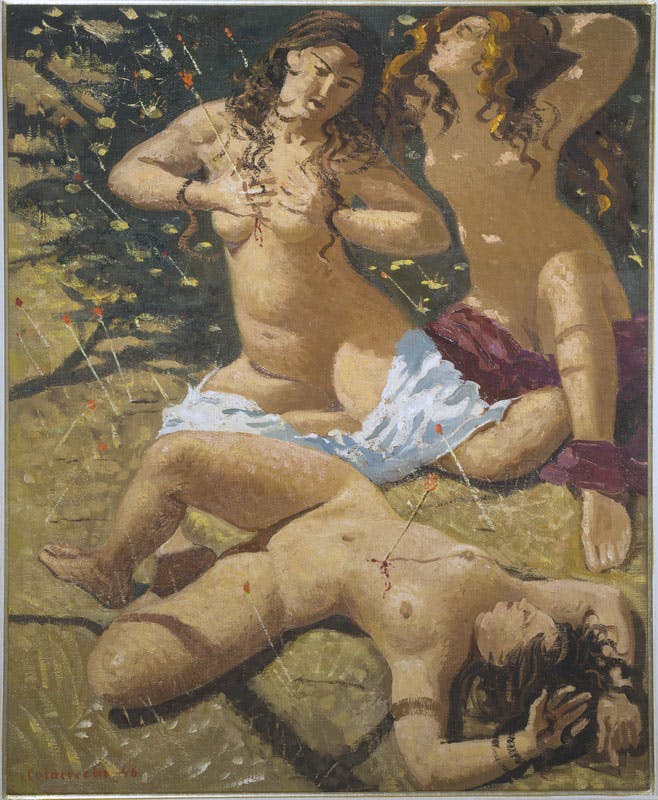Niobidi
Giovanni Colacicchi (Anagni 1900 - Florence 1992)
In 1932, Giovanni Colacicchi turned heads at the Venice Biennale with his painting Amazzoni ferite (Wounded Amazons), purchased during the exhibition by Italian architect and academic Marcello Piacentini. Here too, the composition centres around a group of naked women pierced by arrows, but the scene, set on a white beach and against the background of a dazzling blue sky, dilutes the narrative tension into technical refinements and a lyrical afflatus derived from the climate of "Solaria", the interdisciplinary magazine that aimed to Europeanise Italian culture, of which Colacicchi was one of the founders.
After the war, in 1946, the artist resumed and readapted the subject according to changed expressive urgencies, with a view to enhancing the drama in keeping with the moment of history. The bloody myth of Artemis shooting Niobe’s daughters in revenge is perfectly suited to the purpose, not only for the crudeness of the gesture, but also because it embodies the universal sacrifice of all women, often helpless victims of the violence of conflict. The difference in meaning compared to the 1930s version also requires the artist to make a stylistic adjustment. If the bodies of the wounded Amazons are a reference to the archaic classicism typical of the "Novecento" movement, in this painting we encounter the same greater opulence and sensuality that emanate from the San Sebastiano of 1943, also conserved at the Gallery of Modern Art. Here, Colacicchi confirms his idea of beauty as a unifying and superior value, capable of overcoming even the most ferocious violence, such as the rain of darts that pours down on the defenceless Niobids, but compared to the painting of Saint Sebastian, he increases the dramatic tension by adopting theatrical gestures - the same as in the neo-realist cinema of those years - and a close-up shot that excludes every detail of the environment. The painting is rapidly executed, at times sketchy, played out using studied tonal chords afforded by the artist’s Roman experiences, gained in contact with the artists of the Galleria della Cometa where he had exhibited in 1938, and had been presented in the catalogue by Eugenio Montale. The chromatic exuberance of the two loincloths shines bright in the centre, especially the white one, around which the composition develops.
In a mixture of ethical and aesthetic values, the painting transposes onto the massacre of the Niobids the horrors of war that Colacicchi had opposed by playing a leading role in anti-fascist activity. A commitment that continued well after the conflict. In fact, in 1946 he joined the Partito d'Azione and participated in the Committee for the purge of fascist members established by the Academy of Fine Arts in Florence.
The painting was purchased in 1962 directly from the artist with the intention of extending his works on display in the collection of the Gallery of Modern Art, which at the time was limited to a few landscapes and some still lifes.
San Sebastiano
Giovanni Colacicchi (Anagni 1900 – Firenze 1992)
